英语:Unit5 lesson4 let’s dance教案(北师大版必修2)
- 格式:doc
- 大小:43.50 KB
- 文档页数:2
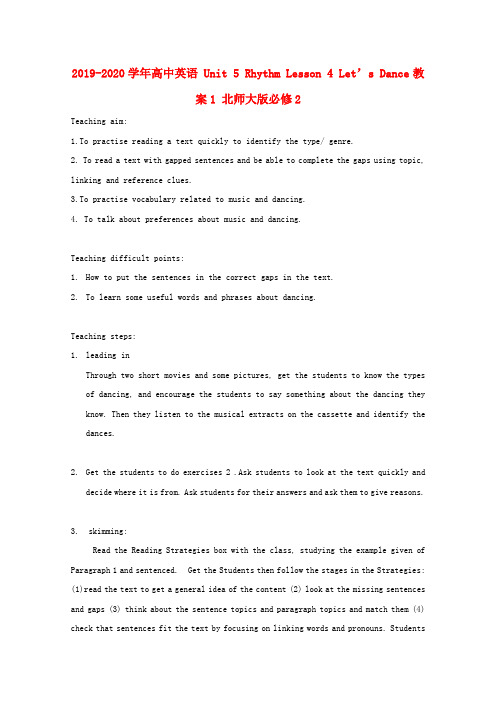
2019-2020学年高中英语Unit 5 Rhythm Lesson 4 Let’s Dance教案1 北师大版必修2Teaching aim:1.To practise reading a text quickly to identify the type/ genre.2. To read a text with gapped sentences and be able to complete the gaps using topic, linking and reference clues.3.To practise vocabulary related to music and dancing.4. To talk about preferences about music and dancing.Teaching difficult points:1.How to put the sentences in the correct gaps in the text.2.To learn some useful words and phrases about dancing.Teaching steps:1.leading inThrough two short movies and some pictures, get the students to know the types of dancing, and encourage the students to say something about the dancing they know. Then they listen to the musical extracts on the cassette and identify the dances.2.Get the students to do exercises 2 .Ask students to look at the text quickly anddecide where it is from. Ask students for their answers and ask them to give reasons.3. skimming:Read the Reading Strategies box with the class, studying the example given of Paragraph 1 and sentenced. Get the Students then follow the stages in the Strategies: (1)read the text to get a general idea of the content (2) look at the missing sentences and gaps (3) think about the sentence topics and paragraph topics and match them (4) check that sentences fit the text by focusing on linking words and pronouns. Studentscan compare their answers in pairs before checking answers as a class.4. scanning:read the text and answer these questions1.who started folk dances?2.what is the main differences between folk and popular dances?3.what is a ballroom dance that came from folk dances?4.Why did a lot of new dances come from the United States?5.What type of solo dancing became popular in the mid-1980s5. intensive readingTrue or false questions1.Ballet is an important art form in Western culture.2.China has not produced any ballets.3.Folk dances are usually solo独个dances.4.Dragon dances and the lion dances are folk dances in China.5.Popular or social dances are usually popular for a long time.6.Ballrom dancing was a formal dance in a large room.7.In the United States, there were only old forms of dance.8.People danced with their partners with ‘disco’ music.3.post-readingfilling the missing words according to the text.nguage points1.from one generation to another 代代相传2.many different types of许多不同类型3.on special occasions在特殊场合4.dress in / be dressed in穿着……5.back and forth 来回地6. to the rhythm of和着。
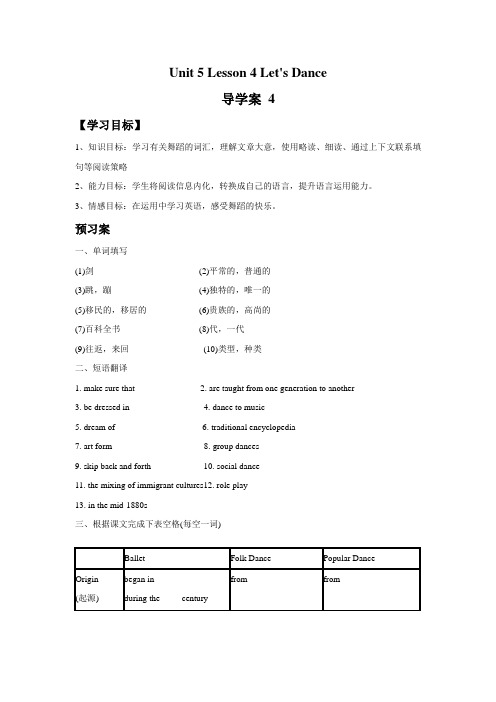
Unit 5 Lesson 4 Let's Dance导学案 4【学习目标】1、知识目标:学习有关舞蹈的词汇,理解文章大意,使用略读、细读、通过上下文联系填句等阅读策略2、能力目标:学生将阅读信息内化,转换成自己的语言,提升语言运用能力。
3、情感目标:在运用中学习英语,感受舞蹈的快乐。
预习案一、单词填写(1)剑(2)平常的,普通的(3)跳,蹦(4)独特的,唯一的(5)移民的,移居的(6)贵族的,高尚的(7)百科全书(8)代,一代(9)往返,来回(10)类型,种类二、短语翻译1. make sure that2. are taught from one generation to another3. be dressed in4. dance to music5. dream of6. traditional encyclopedia7. art form 8. group dances9. skip back and forth 10. social dance11. the mixing of immigrant cultures12. role play13. in the mid-1880s三、根据课文完成下表空格(每空一词)Ballet Folk Dance Popular DanceOrigin (起源) began in _______during the ____ centuryfrom _______ from ______探究案 (课堂交流合作完成)【探究点一】:语篇理解把下列句子填入课文中1-5适当的空格,使文章通顺流畅。
a) In the mid-1980s , break dancing became popular.b) They are easy to learn and are usually danced in couples.c) Other kinds of folk dances are the sword dance and the colorful peacock dance.d) One of the most famous ballets is called “ Swan Lake”.e) In the 1960s , people danced without touching their partner.【探究点二】:字、词、句要点1. be dressed in 穿着e.g. He was dressed in jeans and a T-shirt.他穿着牛仔裤和T 恤衫。
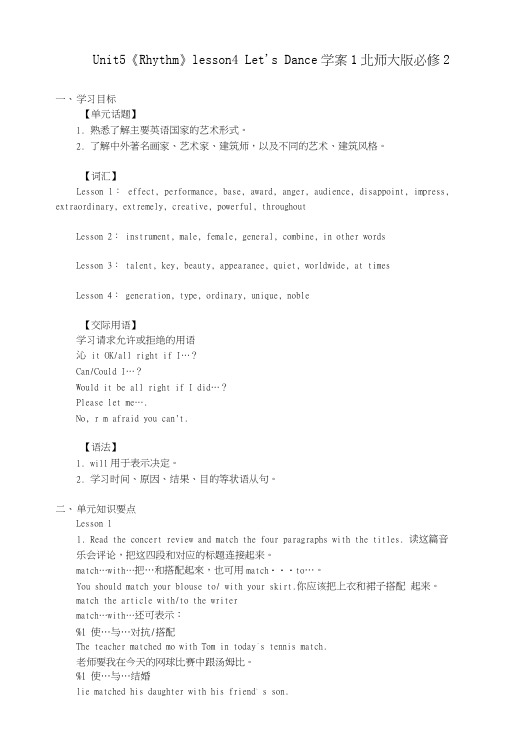
Unit5《Rhythm》lesson4 Let's Dance学案1北师大版必修2一、学习目标【单元话题】1.熟悉了解主要英语国家的艺术形式。
2.了解中外著名画家、艺术家、建筑师,以及不同的艺术、建筑风格。
【词汇】Lesson 1: effect, performance, base, award, anger, audience, disappoint, impress, extraordinary, extremely, creative, powerful, throughoutLesson 2: instrument, male, female, general, combine, in other wordsLesson 3: talent, key, beauty, appearanee, quiet, worldwide, at timesLesson 4: generation, type, ordinary, unique, noble【交际用语】学习请求允许或拒绝的用语沁it OK/all right if I…?Can/Could I…?Would it be all right if I did…?Please let me….No, r m afraid you can't.【语法】1.will用于表示决定。
2.学习时间、原因、结果、目的等状语从句。
二、单元知识要点Lesson 11.Read the concert review and match the four paragraphs with the titles. 读这篇音乐会评论,把这四段和对应的标题连接起来。
match…with…把…和搭配起來,也可用match・・・to…。
You should match your blouse to/ with your skirt.你应该把上衣和裙子搭配起来。
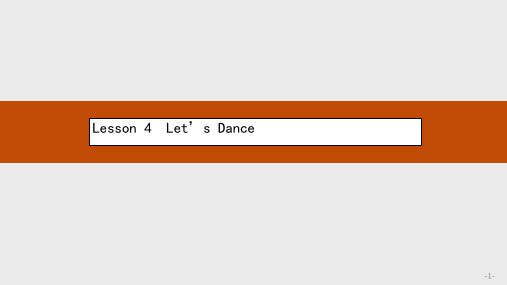

Unit 5 Rhythm Lesson 4 Let’s DanceObjectivesTo practise reading a text quickly to identify the type/genre.To read a text with gapped sentences and be able to complete the gaps using topic, linking and reference clues.To practise vocabulary related to music and dancing.To talk about preferences about music and dancing.Pre-ReadingListen to the music extracts and identify the dances in the box.Example 1 Chinese folk danceKey Wordsdisco, classical ballet, Chinese folk dance, waltz, breakdanceAnswers: 1 Chinese folk dance; 2 classical ballet; 3 waltz; 4 breakdance; 5 disco Some pictures about danceListen to the tape and tell types of dances mentioned.ReadingPut the sentences below in the correct gaps in the text. Use the Strategies to help you.a) In the mid-1980s, breakdancing became popular.b) They are easy to learn and are usually danced in couples.c) Other kinds of folk dances are the sword dance and the colourful peacock dance.d) One of the most famous ballets is called “Swan Lake”.e) In the 1960s, people danced without touching their partner.Answers: 53214True or False‘The Nutcracker’ is a famous America ballet.( F )Ballet are performed by professional dancers. ( T )Folk dance are usually popular for only a short time.( F )Yangge is performed in Christmas celebration. ( F )Rumba and Cha-Cha are folk dances.( F )African-American rhythm and movements play an important part in the development of popular dance. ( T )Popular dance are taught from one generation to another.( F )Post-ReadingRead the text again and answer these questions.1 Who started folk dance?Ordinary people.2 What is the main difference between folk and popular dances?Popular dances are usually popular for only a short time.3 What is a ballroom dance that came from folk dance?Waltz.4 Why did a lot of new dances come from the United States?The mixing of immigrant cultures produced new forms of dance.5 What type of dancing became popular in the mid-1980s?Breakdancing.VocabularyMake compound words by matching one word from each list.African known African-Americanball American ballroomrock room rock musicart dance art formwell 1980s well-knownmid form mid-1980sfolk music folk danceMatch four words from Exercise 5 with their definitions.1 adj. known by many people2 noun. a traditional dance from a specific community3 noun. a large room for formal social dancing4 noun. in the middle of the 1980sAnswers: 1 well-known; 2 folk dance; 3 ballroom; 4 mid-1980sSpeakingRead this questionnaire and think about your answers. Then in pairs, tell your partner about yourself.DO YOU WANNA DANCE?1 Do you like dancing?2 What kind of dance do you like?3 What kind of music do you like dancing to?4 How well can you dance?5 What special dances can you do?6 What dance would you like to learn?Writing你身边最熟悉的舞蹈是什么呢?仿照课文的思路,写一篇作文,介绍一下在你所在的地方的舞蹈形式。
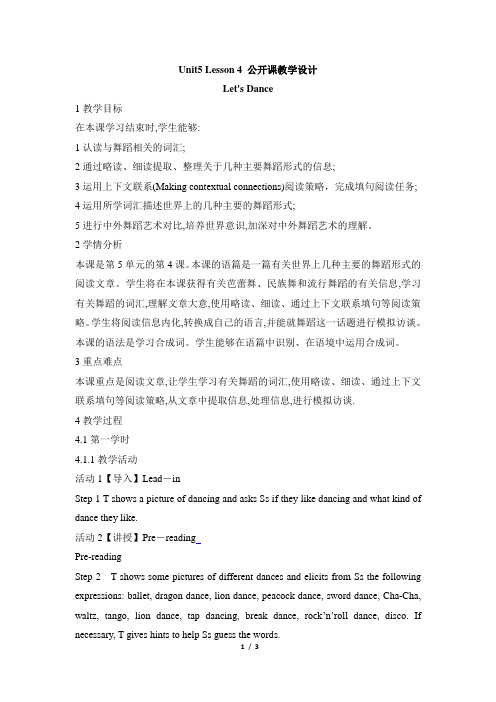
Unit5 Lesson 4 公开课教学设计Let's Dance1教学目标在本课学习结束时,学生能够:1认读与舞蹈相关的词汇;2通过略读、细读提取、整理关于几种主要舞蹈形式的信息;3运用上下文联系(Making contextual connections)阅读策略,完成填句阅读任务; 4运用所学词汇描述世界上的几种主要的舞蹈形式;5进行中外舞蹈艺术对比,培养世界意识,加深对中外舞蹈艺术的理解。
2学情分析本课是第5单元的第4课。
本课的语篇是一篇有关世界上几种主要的舞蹈形式的阅读文章。
学生将在本课获得有关芭蕾舞、民族舞和流行舞蹈的有关信息,学习有关舞蹈的词汇,理解文章大意,使用略读、细读、通过上下文联系填句等阅读策略。
学生将阅读信息内化,转换成自己的语言,并能就舞蹈这一话题进行模拟访谈。
本课的语法是学习合成词。
学生能够在语篇中识别、在语境中运用合成词。
3重点难点本课重点是阅读文章,让学生学习有关舞蹈的词汇,使用略读、细读、通过上下文联系填句等阅读策略,从文章中提取信息,处理信息,进行模拟访谈.4教学过程4.1第一学时4.1.1教学活动活动1【导入】Lead-inStep 1 T shows a picture of dancing and asks Ss if they like dancing and what kind of dance they like.活动2【讲授】Pre-readingPre-readingStep 2 T shows some pictures of different dances and elicits from Ss the following expressions: ballet, dragon dance, lion dance, peacock dance, sword dance, Cha-Cha, waltz, tango, lion dance, tap dancing, break dance, rock’n’roll dance, disco. If necessary, T gives hints to help Ss guess the words.While eliciting the expressions, T demonstrates the pronunciation and Ss practice reading them aloud after T.T goes over the pictures again and asks Ss to say the words from their memory.Step 3 T asks Ss to listen to the music extracts and identify the dances in the box.活动3【活动】教学活动While-readingStep 41st reading: Ss skim the text and decide where the text is from.T elicits from Ss the meaning of encyclopedia and demonstrates the pronunciation. Ss practice the pronunciation after T.Step 52nd reading: T goes through reading strategies of making contextual connections with Ss.Ss read to put the sentences in the correct gaps in the text, using topic, linking and reference clues.活动4【练习】课堂练习Step 63rd reading: Ss read the text carefully and fill in the table with the information about different types of dancing.Ss work in pairs and check the information they get from the text. Then T gets the feedback from the whole class.Step 7 Ss read four sentences carefully and do the exercises about True or False.活动5【测试】课堂测试Post-readingStep 8 T demonstrates asking and answering questions about the information on the screen with a student. Then Ss work in pairs, asking and answering questions about different dances.Step 9 V olunteer pairs present in front of the whole class, and the rest of the class evaluate their presentation.活动6【作业】Homework Write a summary of the passage.。
英语:Unit5《Rhythm》lesson4 let us dance学案(北师大版必修2)英语中表示“穿、戴”两个常用词语put on与wear的区别比较显著,也比较容易。
前者表示动作,后者表示状态(常用进行时态),这两个词语既可以表示穿衣,也可以表示戴帽(cup),戴眼镜(glasses),戴花(flowers),戴饰物等,都作及物动词(组)用,如:He's putting on his clothes.他正在穿衣服。
It's best to wear cool clothes.最好穿浅色衣服。
而dress只能用于“穿衣”,又可兼作及物动词和不及物动词,作不及物动词用时,既可以表示动作,又可以表示状态,即含有put on clothes和wear clothes两种意义,如:Get up and dress quickly。
起来,快点穿衣服。
(表示动作)Rose dresses much better than before。
罗斯穿得比过去好多了。
(表状态)dress作及物动词时,不接clothes之类的表示衣服的名词,而是接表示人的句词或代词,意思是“给……穿衣服”。
当表示自己穿衣服时,则用反身代词,如:Wake up children and dress them.唤醒孩子,给他们穿上衣服。
She isn't old enough to dress herself.她太小,不会自己穿衣服。
dress的过去分词常用来构成get dressed与be dressed短语,前者表示动态,后者表示静态,穿何种衣服,则用介词in.如:He could not wash himself or get dressed.他还不能自己梳洗或穿衣。
The girl was dressed in red.这个女孩穿着一身红衣服。
dress up是“穿上最好的衣服”,常指“打扮,化装”,如:Let's dress up and go out to the theatre.咱们穿戴整齐到戏院看戏吧。
Unit 5 Rhythm Lesson 4 Let’s Dance 第2课时【学习目标】1.Learning objectives 知识目标① To master the key words and phrases: ordinary, unique, refer to …掌握重点单词和短语的用法② To learn compound words学习复合词2. Emotional objectives 情感目标To know about the features of different dances. 了解不同舞蹈的特色【重点和难点】知识目标的第①和②点。
【学法指导】 Compound words :通过观察例句,在课文中发现更多的具有合成词的句子,体会合成词的用法。
归纳和整理关于合成词的语法规则,保证对此理解准确。
【学习过程】(一) Preview 课前预习导学1. 本课核心短语---(寻读skimming课文,在文中打记并填写---与同桌分工完成 )1).______________往返,来回, 前前后后 2).__________________ 穿着3)._______________涉及,参考,提及 4).___________________18世纪末5)._______________ 诸如 6). ______________________在特殊的时候7)._______________与……一致 8)._______________________确保9). _________________在20世纪七十年代 10). ______________一代又一代2. 试着用学法指导, 观察下列例句中划线部分,体会合成词的用法。
1)Chinese ballet is called “The White-haired Girl”.2)3)dancing, which was a formal dance in a large room, became more popular.4)are traditional styles of dancing that come from ordinary people. 归纳和整理关于合成词的语法规则:_______________________________________________________________________________ _______________________________________________________________________________3. Make compound words: Ex 5, 6 on Page 29.(二) Classroom learning and exploration 课堂学习和研讨1. Presentation of the preview 预习成果展示2. Explanation and discussion 答疑讨论3. Classroom learning tasks 课堂学习探究任务1. ordinary adj.普通的,平常的,通常的 ( not different or special)I thought the paintings were pretty ordinary.我认为这些画是泛泛之作。
Unit 5 《Rhythm》lesson4Let's Dance教师寄语:Without music, life is a journey through a desert.I think without dance, life is also a journey through a desert.学习目标:㈠、知识与能力目标:掌握本课的重要单词及短语的用法,能运用课本P28的阅读策略完成阅读填空任务。
㈡、过程与方法:通过学生自主探究和合作探究完成本课阅读任务,提高阅读能力;通过教师点拨学会词义辨析,掌握本课的重要单词及短语的用法。
㈢、情感态度目标:了解不同背景下的舞蹈类型,培养艺术爱好和异国文化意识并提高英语学习兴趣。
学习重点:提高学生阅读能力并掌握重要词组及句型。
学习难点:如何提高学生阅读能力。
学习过程:一、知识梳理A 1、adj.平常的,普通的→(反义词)独特的2、n类型,种类→(近义词)3、adj高贵的→n贵族绅士4、n移民→v5、n舞厅→n舞会→n/v 舞蹈6、n传统→adj→adv7 跳过,不做__________B、1、因…著名2、普通人__________3、来来回回4、受到…的欢迎__________5、第二次世界大战___________________________________6、在二十世纪七十年代_______________________________7、世世代代8、穿着___________二、自主探究1、Write some words about dance.2、c)Other kinds of folk dances are the sword dance and the colourful peacock dance.d)One of the most famous ballets is called"SwanLake".e)In the 1960s,people danced without touching their partner.3、Read the text again and fill in the form.三、合作探究1). Why did a lot of new dances e from the United States ?2). How and what can we municate through the language of dance?2.精讲点拨1.ordinary adj 普通的,平常的eg:The book I have read recently is about ordinary people.我最近看的这本书是关于普通人的。
Lesson4 Let’s Dance教案(reading) Teaching aims(教学目标):
Knowledge aims(知识目标)
1. To make the students learn and grasp the new words and expressions
2 To let the students know some types of dances
3. To read a text with gapped sentences and be able to complete the gaps using topic,
structure , linking and reference clues.
4. To talk about preferences about dancing.
Ability aims(能力目标)
1.To develop the students’ ability of getting the general idea
2.To develop the students’ ability of analysing the structure of the article
3.To improve the students’ ability of getting the detailed information
Emotion aims(情感目标):
To develop the students’ value of appreciating beauty
Teaching important points(教学重点):
1 How to put the sentences in the correct gaps in the text.
2 To learn some useful words and phrases about dancing.
Teaching difficult point(教学难点)
To develop the students’ reading ability
Teaching steps(教学步骤)
Step1 Lead-in(导入)
Through two pictures ,let the students know what we we are going to learn. and encourage the students to say something about the dancing they know. Then they listen to the musical extracts on the cassette and identify the dances.
step2 Vocabulary teaching(词汇教学)
Show some beautiful pictures to help the students better learn some mew words as well as to attract their attention
step3 Reading(阅读)
Skimming(跳读)
Fristly ,get the students to do exercises 2 .Ask them to skim through the text quickly and decide where it is from.
Fast reading(快读)
Then read the Reading Strategies box with the class, studying the example given of Paragraph 1 and sentenced. Get the Students then follow the stages in the Strategies: (1)read the text to get a general idea of the content (2) look at the missing sentences and gaps (3) think about the sentence topics and paragraph topics and match them (4) check that sentences fit the text by focusing on linking words and pronouns. Students can compare their answers in pairs before checking answers as a class.
Careful reading(精读)
●Read the three parts carefully one by one and answer these questions
1.who started folk dances?
2.what is the main differences between folk and popular dances?
3.what is a ballroom dance that came from folk dances?
4.Why did a lot of new dances come from the United States?
5.What type of solo dancing became popular in the mid-1980s
●True or false questions
1.Ballet is an important art form in Western culture.
2.China has not produced any ballets.
3.Folk dances are usually solo独个dances.
4.Dragon dances and the lion dances are folk dances in China.
5.Popular or social dances are usually popular for a long time.
6.Ballrom dancing was a formal dance in a large room.
7.In the United States, there were only old forms of dance.
8.People danced wi th their partners with ‘disco’ music.
Step4 Post-reading(读后)
Fill the missing words according to the text.
Area Types Dance People Place for
performance
Ballet
Folk dance
Popular dance
Step5 Discussion()
Question1 Do you think it is necessary to open a dance lesson in our school?
Question2 If opened ,what dance would you like to learn?
Step3 Homework(作业)
1. Remember the new words by heart after class
2.Do the exercises (一篇七选五,一篇阅读理解)
3. U se the students’ own wo rds to describe the types of the dancing they learn from the text.。